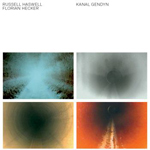|
|
 |
Dusted Reviews
Artist: Russell Haswell and Florian Hecker Album: Kanal GENDYN Label: Editions Mego Review date: Feb. 8, 2012 |

|
|
|
 |
At times, I’m reminded of the differences and similarities between creating visual works and sound works. Is painting a pleasant pastoral scene akin to recording a pop tune, while a Jackson Pollock is similar to, say, Throbbing Gristle? It’s obviously not quite so simple, but the analogy can be helpful nonetheless. The act of looking at a "difficult picture" — not to mention defining what that means — isn’t the same as listening to a difficult recording. But the challenges for both the creator and the consumer are similar. What’s the intended message? Is the creator trying to induce a particular reaction, or is the reaction beside the point? Should the consumer take the difficulty of the work as a statement, or is it a by-product of the statement itself — or entirely disconnected?
Some of these thoughts come to mind while listening to Kanal GENDYN, an electronic soundtrack to a 1992 short film, Kanal Video. The film, by Swiss artists Peter Fischli and David Weiss, is a sort of journey through the sewer system in Zurich. In 2004, Russell Haswell and Florian Hecker performed a real-time soundtrack to the film during a showing. Drawing on their studies of Iannis Xenakis and abstract sound synthesis, the duo utilized the program GENDYN for the performance. The program, based on algorithms by Xenakis and originally written by the composer, uses dynamic stochastic synthesis to generate waveforms through probabilities, with no external inputs. In other words, it’s a sort of "automatic composition" in which the software and its algorithms are responsible for the creation of the sounds.
It’s unclear whether this recording was purely created by GENDYN or whether Haswell and Hecker augmented or manipulated the sounds during the performance. In either case, this is fairly difficult listening most of the time. Sometimes the abstract tones overlap in intriguing ways; at other times, they become grating. During the first part, for example, there are some moments of very pure, constant tones that made me want to turn it off. The ever-shifting sounds are most often purely mechanical, artificial, like a swarm of robot bees or the inside of a giant computer.
What makes it most difficult to grasp, though, is its chaotic nature. There’s so much randomness involved that the brain wants to sense reasons behind the moves — the result is that it’s difficult to maintain interest, since what came before doesn’t feel like it leads to what’s currently happening. I simply found myself unable to care, because it didn’t matter what happened next. That said, if this could be viewed with the film, as it was during its creation, it might find connections. Or it might not. Since Kanal GENDYN is being released as an LP+DVD set with the DVD as an audio-only 4.0 DTS disc, it’s difficult to know.
So I find myself wondering about the intent here, and whether it’s truly meant as a listening experience or more as an experiment, putting the GENDYN output to the listening test. Or perhaps it’s testing the listener instead. The twin narratives of soundtrack-without-film and composition-without-input make Kanal GENDYN a release doubly removed from connections ordinarily expected. Unfortunately, judged solely on the audio evidence provided, the result is not entirely welcome.
By Mason Jones
|







